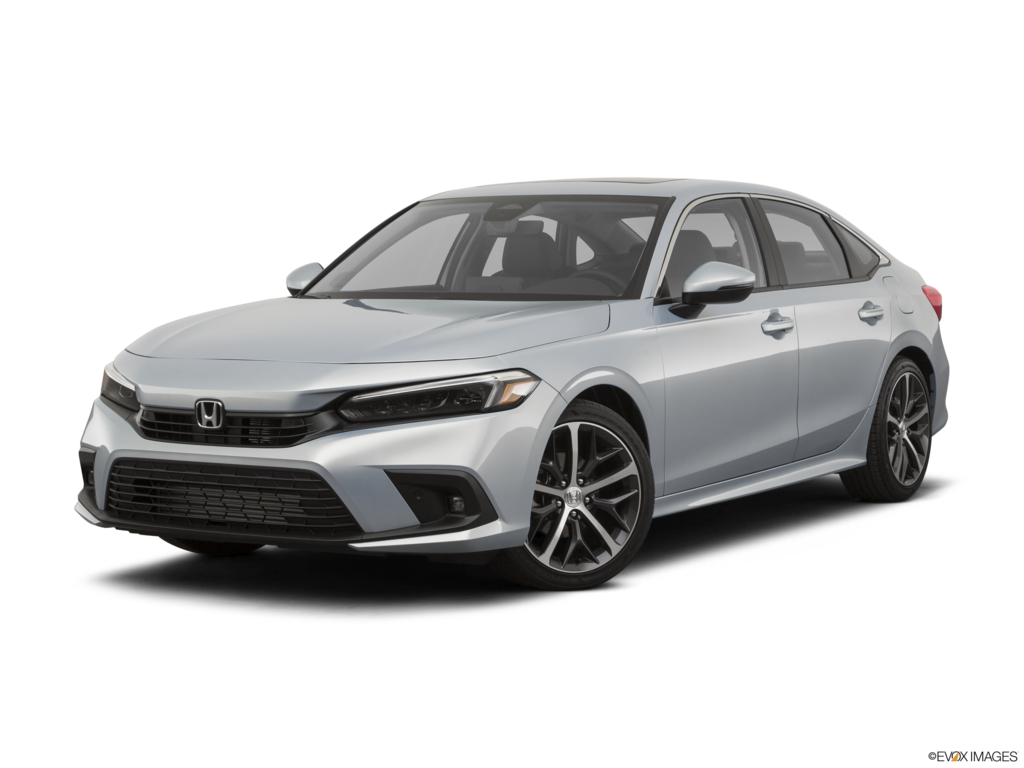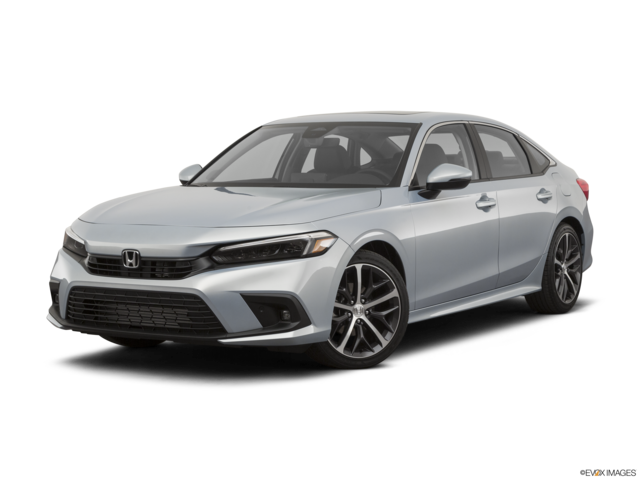
Eleventh generation Honda Civic
The Honda Civic is a car that can cover all the bases from economy to performance. Available in a useful hatchback or comfortable sedan format, the Civic offers a choice between a gas-fueled or hybrid driveline, with a six-speed manual transmission in the sporty Civic Si and Type R models.
The Civic offers a sleek body shape from both the hatchback version, with its coupe-like profile, or the traditional four-door sedan. All Civic models are front-wheel-drive, and most feature an advanced continuously variable automatic transmission.
The Civic seats five people, and features a touchscreen infotainment system with Apple and Android phone integration as well as native Google hands-free apps. Additional available tech features include wireless device charging, a control app for your phone, blind-spot monitoring, and a multi-angle rearview camera system.
Model highlights
Available hybrid engine (added for 2025)
Available Civic Si and Type R performance models
Standard driver-assist technology
Lightly refreshed bodywork (added for 2025)
No coupe offered for this generation
Tenth generation Honda Civic
The tenth generation Honda Civic featured a new global architecture and a sporty two-door coupe body style that was dropped in 2021.
The tenth generation Honda Civic offers both economy and sporty fun. Depending on the trim level you choose, you can have a powerful engine and manual transmission, or a more economical choice with an automatic, though no hybrid was available. All tenth generation Civics share a sporty look and will seat up to five. Starting with the 2017 model year, the Civic Si offers turbocharged power and a more sport-oriented chassis. In the same year, Honda unveiled the Civic Type R, with even more power and a racing-inspired chassis.
For the 2019 model year, Honda gave all Civic models a light bodywork refresh and made the Honda Sensing® suite of driver-assist features standard. Honda Sensing includes adaptive cruise control, lane centering, traffic sign recognition, automatic high beams, and blind-spot monitoring.
Model highlights
Available two-door coupe and performance models
Standard Honda Sensing safety suite (2019 and newer)
Hatchback body style (2017 and newer)
Continuously variable transmission
Hybrid discontinued
Ninth generation Honda Civic
The ninth-generation Honda Civic offers affordable, reliable transportation with what the company called an "energetic, sleek, and aerodynamic" body. That’s why the ninth-generation Civic looks as fresh and relevant today as it did when it was new.
The ninth-generation Honda Civic was available as a four-door sedan or two-door coupe. No hatchback was included in this generation. Trim levels ranged from the austere HF model, designed for the maximum fuel economy in a gas-only vehicle, to the sporty Civic Si model and a thrifty Civic Hybrid. Depending on the trim level, buyers could select a five- or six-speed manual transmission, a five-speed automatic, or a continuously variable transmission. All Civic models in this generation used front-wheel drive.
Annual updates to the Civic through this generation reflected the fast pace of technological change in the auto industry at the time. In 2013 the Civic received its first rear-view camera and Bluetooth® hands-free phone support, as well as suspension and chassis updates. Starting in 2014, Civic models were available with a touchscreen infotainment system.
Model highlights
Available hybrid and high fuel economy (HF) models
Bluetooth and backup camera (added for 2013)
Available touchscreen infotainment (added for 2014)
Changes by year
Latest generation from 2022 - 2025
2025 Honda Civic
Highlights
Hybrid powertrain added
Revised front end styling
Top trim level gets Google-based infotainment
Learn more
2024 Honda Civic

2023 Honda Civic

2022 Honda Civic

Highlights
Redesigned for 2022 with new styling
Available as a sedan or hatchback, no more coupe
Slightly larger this time around, with more interior space
Larger nine-inch screen available
New 10.2-inch digital instrument cluster
Learn more
Previous generation from 2016 - 2021
2021 Honda Civic

Highlights
Civic Si and coupe dropped
Sedan and hatchback received no significant changes
Type R Limited Edition introduced with lighter weight and special paint, wheels, and tires
Learn more
2020 Honda Civic

Highlights
Hatchback and Civic Si received updated front and rear styling
Sedan stood pat
Civic Si got revised transmission gearing and interior trim
Improved suspension and brakes for Civic Type R
Learn more
2019 Honda Civic

Highlights
Sport trim offered for sedan and coupe
Sport base engine changed from 1.5-liter to 2.0-liter four-cylinder
Revised front bumper
Volume knob and hard buttons added to available infotainment system
Learn more
2018 Honda Civic

2017 Honda Civic

Highlights
Hatchback body style added
Turbocharged four-cylinder standard in hatchback, where it made slightly more power
Civic Si returned
Civic Type R added
Learn more
2016 Honda Civic
Highlights
Full redesign for 2016
Offered as a sedan or coupe
New wider and lower styling
New 2.0-liter four-cylinder and 1.5-liter turbocharged four-cylinder engines
Civic Si, Hybrid, and Natural Gas versions not offered
Learn more
Previous generation from 2012 - 2015
2015 Honda Civic
2014 Honda Civic
Highlights
Refreshed front and rear styling for coupe
Continuously variable transmission replaced five-speed automatic
Firmer suspension tuning for LX coupe and Si
New features included keyless ignition, a touchscreen infotainment system, a blind-spot camera, and enhanced smartphone integration
Learn more
2013 Honda Civic
Highlights
Refreshed exterior styling
More standard features
Quieter cabin
Retuned suspensions
Upgraded interior materials
Learn more
2012 Honda Civic
Highlights
Redesigned for 2012 with cheaper interior materials, less refinement
Larger four-cylinder with more power for Civic Si
Mild styling update
Improved fuel economy
Stability control standard
More interior space
Learn more
Looking for 2012 models or older?
CarMax only sells 2013 models and newer. But no matter the year, we'll happily buy your car.
Reliability
RepairPal gave the Honda Civic an overall reliability rating of 4.5 out of 5 stars, which RepairPal describes as Excellent. This rating ranks Honda Civic 3rd out of 46 among Compact Cars.
RepairPal reports that the average total annual cost for repairs and maintenance on a Honda Civic is $335, compared to an average of $453 for Compact Cars and $591 for all the vehicles RepairPal considered in its dataset.
According to RepairPal, Honda Civic owners bring their vehicles into a repair shop for unscheduled repairs an average of 0.8 times per year, compared to an average of 1.1 times for Compact Cars and 1.3 times for all the vehicles RepairPal considered in its dataset.
RepairPal reported that the probability of a repair being a severe or major issue is 9% for the Honda Civic, compared to an average of 12% for Compact Cars and 14% for all the vehicles RepairPal considered in its dataset.
We hope you found this information helpful. This content is intended to inform and is not meant to provide legal, financial or investment advice. We make every effort to provide accurate information, but please verify before transacting and consider talking to a qualified professional about your unique circumstances.
Statements of fuel economy or EV range are based on EPA and other third-party estimates for vehicles when new. Fuel economy and EV range will degrade with time and vary based on age, driving conditions, vehicle history, and other conditions. See fueleconomy.gov for more info.
Editorial content contained on this page comes from Edmunds.com, Inc., a subsidiary of CarMax Enterprise Service, LLC, and information related to featured vehicles comes from third-party sources, including manufacturer information. Product and company names may be trademarks or registered trademarks of third-party entities. Use of them does not imply any affiliation with or endorsement by these entities. By clicking on any video links, you will be taken to a third-party site maintained by YouTube, Inc.



